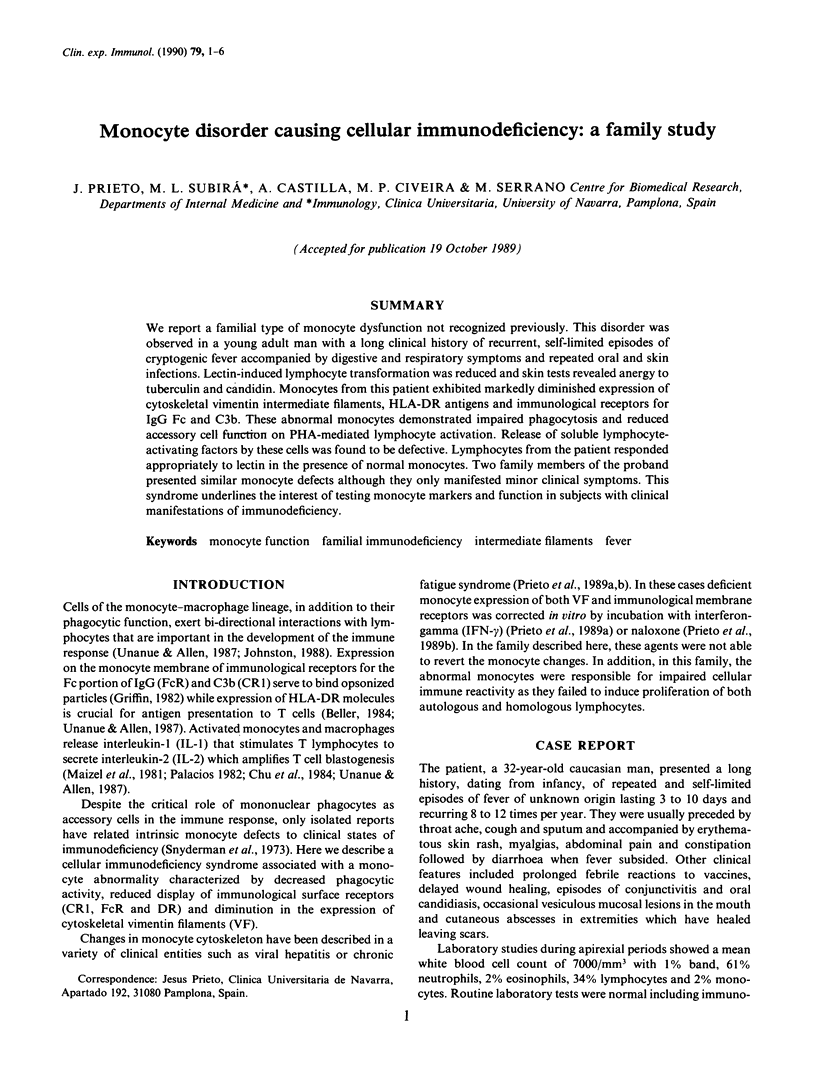Abstract
We report a familial type of monocyte dysfunction not recognized previously. This disorder was observed in a young adult man with a long clinical history of recurrent, self-limited episodes of cryptogenic fever accompanied by digestive and respiratory symptoms and repeated oral and skin infections. Lectin-induced lymphocyte transformation was reduced and skin tests revealed anergy to tuberculin and candidin. Monocytes from this patient exhibited markedly diminished expression of cytoskeletal vimentin intermediate filaments, HLA-DR antigens and immunological receptors for IgG Fc and C3b. These abnormal monocytes demonstrated impaired phagocytosis and reduced accessory cell function on PHA-mediated lymphocyte activation. Release of soluble lymphocyte-activating factors by these cells was found to be defective. Lymphocytes from the patient responded appropriately to lectin in the presence of normal monocytes. Two family members of the proband presented similar monocyte defects although they only manifested minor clinical symptoms. This syndrome underlines the interest of testing monocyte markers and function in subjects with clinical manifestations of immunodeficiency.
Full text
PDF





Selected References
These references are in PubMed. This may not be the complete list of references from this article.
- Beller D. I. Functional significance of the regulation of macrophage Ia expression. Eur J Immunol. 1984 Feb;14(2):138–143. doi: 10.1002/eji.1830140207. [DOI] [PubMed] [Google Scholar]
- Broff M. D., Jonsen M. E., Geha R. S. Nature of the immunogenic moiety recognized by the human T cell proliferating in response to tetanus toxoid antigen. Eur J Immunol. 1981 May;11(5):365–371. doi: 10.1002/eji.1830110504. [DOI] [PubMed] [Google Scholar]
- Chu E., Rosenwasser L. J., Dinarello C. A., Lareau M., Geha R. S. Role of interleukin 1 in antigen-specific T cell proliferation. J Immunol. 1984 Mar;132(3):1311–1316. [PubMed] [Google Scholar]
- Geiger B. Intermediate filaments. Looking for a function. Nature. 1987 Oct 1;329(6138):392–393. doi: 10.1038/329392a0. [DOI] [PubMed] [Google Scholar]
- Johnston R. B., Jr Current concepts: immunology. Monocytes and macrophages. N Engl J Med. 1988 Mar 24;318(12):747–752. doi: 10.1056/NEJM198803243181205. [DOI] [PubMed] [Google Scholar]
- Khansari N., Chou Y. K., Fudenberg H. H. Human monocyte heterogeneity: interleukin 1 and prostaglandin E2 production by separate subsets. Eur J Immunol. 1985 Jan;15(1):48–51. doi: 10.1002/eji.1830150110. [DOI] [PubMed] [Google Scholar]
- Maizel A. L., Mehta S. R., Ford R. J., Lachman L. B. Effect of interleukin 1 on human thymocytes and purified human T cells. J Exp Med. 1981 Feb 1;153(2):470–475. doi: 10.1084/jem.153.2.470. [DOI] [PMC free article] [PubMed] [Google Scholar]
- Mittal K. K., Mickey M. R., Singal D. P., Terasaki P. I. Serotyping for homotransplantation. 18. Refinement of microdroplet lymphocyte cytotoxicity test. Transplantation. 1968 Nov;6(8):913–927. doi: 10.1097/00007890-196811000-00006. [DOI] [PubMed] [Google Scholar]
- Morahan P. S., Connor J. R., Leary K. R. Viruses and the versatile macrophage. Br Med Bull. 1985 Jan;41(1):15–21. doi: 10.1093/oxfordjournals.bmb.a072017. [DOI] [PMC free article] [PubMed] [Google Scholar]
- Palacios R. Mechanism of T cell activation: role and functional relationship of HLA-DR antigens and interleukins. Immunol Rev. 1982;63:73–110. doi: 10.1111/j.1600-065x.1982.tb00412.x. [DOI] [PubMed] [Google Scholar]
- Prieto J., Castilla A., Subirá M. L., Serrano M., Morte S., Civeira M. P. Cytoskeletal organization and functional changes in monocytes from patients with chronic hepatitis B: relationship with viral replication. Hepatology. 1989 May;9(5):720–725. doi: 10.1002/hep.1840090511. [DOI] [PubMed] [Google Scholar]
- Prieto J., Subirá M. L., Castilla A., Arroyo J. L., Serrano M. Opioid peptides modulate the organization of vimentin filaments, phagocytic activity, and expression of surface molecules in monocytes. Scand J Immunol. 1989 Apr;29(4):391–398. doi: 10.1111/j.1365-3083.1989.tb01138.x. [DOI] [PubMed] [Google Scholar]
- Prieto J., Subirá M. L., Castilla A., Serrano M. Naloxone-reversible monocyte dysfunction in patients with chronic fatigue syndrome. Scand J Immunol. 1989 Jul;30(1):13–20. doi: 10.1111/j.1365-3083.1989.tb01183.x. [DOI] [PubMed] [Google Scholar]
- Rouse B. T., Horohov D. W. Immunosuppression in viral infections. Rev Infect Dis. 1986 Nov-Dec;8(6):850–873. doi: 10.1093/clinids/8.6.850. [DOI] [PMC free article] [PubMed] [Google Scholar]
- Snyderman R., Altman L. C., Frankel A., Blaese R. M. Defective mononuclear leukocyte chemotaxis: a previously unrecognized immune dysfunction. Studies in a patient with chronic mucocutaneous candidiasis. Ann Intern Med. 1973 Apr;78(4):509–513. doi: 10.7326/0003-4819-78-4-509. [DOI] [PubMed] [Google Scholar]
- Toribio M. L., De Landázuri M. O., López-Botet M. Induction of natural killer-like cytotoxicity in cultured human thymocytes. Eur J Immunol. 1983 Dec;13(12):964–969. doi: 10.1002/eji.1830131203. [DOI] [PubMed] [Google Scholar]
- Unanue E. R., Allen P. M. The basis for the immunoregulatory role of macrophages and other accessory cells. Science. 1987 May 1;236(4801):551–557. doi: 10.1126/science.2437650. [DOI] [PubMed] [Google Scholar]
- Warner S. J., Libby P. Human vascular smooth muscle cells. Target for and source of tumor necrosis factor. J Immunol. 1989 Jan 1;142(1):100–109. [PubMed] [Google Scholar]


